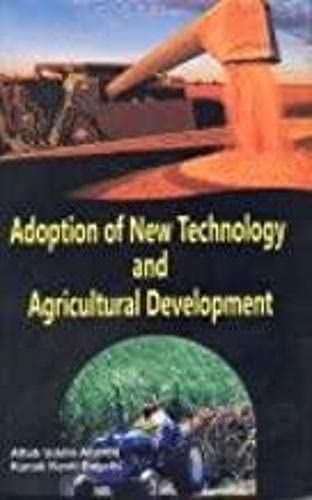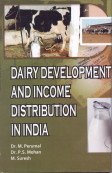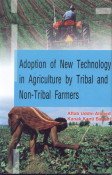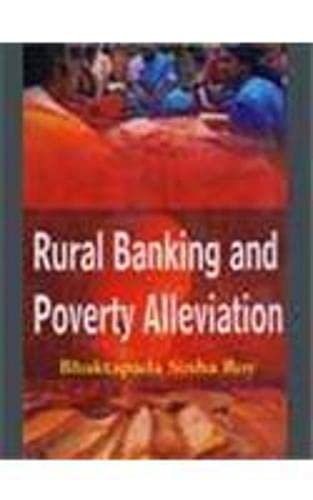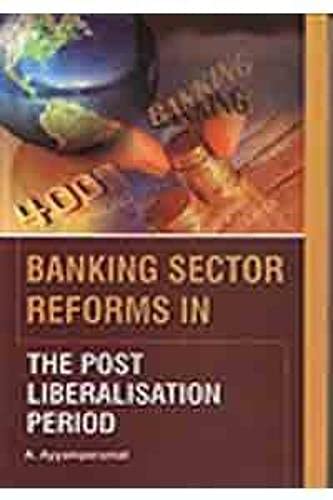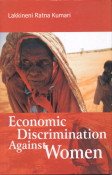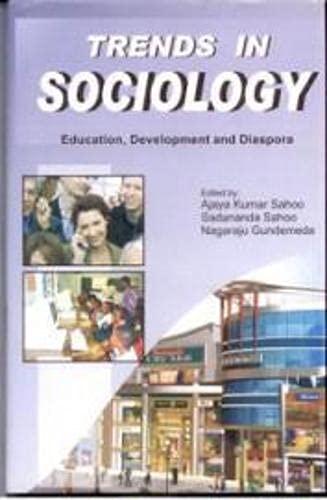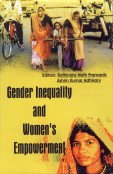abhijeet pub delhi (55 results)
Product Type
- All Product Types
- Books (55)
- Magazines & Periodicals
- Comics
- Sheet Music
- Art, Prints & Posters
- Photographs
- Maps
-
Manuscripts &
Paper Collectibles
Condition
- All Conditions
- New
- Used
Binding
- All Bindings
- Hardcover
- Softcover
Collectible Attributes
- First Edition
- Signed (1)
- Dust Jacket (10)
- Seller-Supplied Images
- Not Printed On Demand
Seller Location
Seller Rating
-
Adoption of New Technology and Agricultural Development
Published by Abhijeet Pub, Delhi, 2007
ISBN 10: 8189886045ISBN 13: 9788189886042
Seller: Vedams eBooks (P) Ltd, New Delhi, India
Book
Hardbound. Condition: As New. New. Contents 1. Introduction. 2. State of agricultural development in Assam. 3. Spread of new agricultural technology in Assam and general and Barpeta District in particular. 4. Adoption of agricultural technology in Barpeta District a farm level analysis. 5. Role of agricultural extension personnel in percolation of new technology. 6. Factors and constraints affecting adoption of new agricultural development. 7. Summary conclusions and suggestions. Bibliography. Appendices. In this study an attempt has been made to identify the factors that influence the adoption or non adoption of new technology in Indian agrarian situation in general and the agricultural situation of Barpeta District of Assam in particular. Identification of such factors would obviously help us to some extent to know how we will be able to use modern agricultural technology for agricultural growth and what measures are to be taken by the govt. as well as by the farmers for adoption of modern agricultural technology. The present investigation was conducted in a limited geographical area consisting of particular agro climatic and socio economic conditions of Barpeta District of Assam. Therefore the findings emanating from the study may not be applicable in all types of agro climatic and socio economic conditions our country. Of course the findings of the present study would be applicable in Assam and elsewhere having similar agro climatic and socio economic condition while the general conclusions arrived at may be of value in other spheres subject to local adjustments. 154 pp.
-
Ethnic Unrests and Indias Security Concerns
Published by Abhijeet Pub, Delhi, 2008
Seller: Vedams eBooks (P) Ltd, New Delhi, India
Signed
Hardbound. Condition: As New. New. Contents Acknowledgements. 1. Introduction and conceptual basis. 2. The Chittagong Hill tracts political crisis and political movement of the Jummas. 3. The Chittagong Hill tracts political crisis and India's national security internal and external dimension. 4. The Chittagong Hill tracts political crisis and the Government of India policy. Conclusion. Bibliography. The Chittagong Hill Tracts (CHT) political crisis is one of the oldest ethnic problems in the postcolonial reconstruction of the South Asian State. Apiece accord was signed on 2 December 1997 between the then Government of Bangladesh and the Parbattya Chittagram Jana Samhati Samiti (PCJSS) with the following objectives i. To end decades old ethnic insurgency in the CHT. ii. To establish peace and political stability in the CHT and iii. To establish rights of the Jummas of the CHT. Almost ten years have passed since the conclusion of the accord however peace and political normalcy is yet to come back in the CHT. Instead the situation has become has become more volatile and explosive in nature. Therefore the primary argument of this book is that the CHT political crisis is yet to be over. The book analyzes the impact of the CHT political crisis on the India's national security. Instead of defining national security in narrower sense as the realists define always in term of interests here it has been defined in broader perspective. It argues that realist's definition of security in term of national interests is not meant for all strata of society. It cannot provide comprehensive security for all. Therefore the operational development of the security as brought out in the book argues that security be comprehensive requires on emphasizing on human security for all. 142 pp.
-
Marginalised Poor in India
Published by Abhijeet Pub, Delhi, 2007
Seller: Vedams eBooks (P) Ltd, New Delhi, India
Hardbound. Condition: As New. New. Contents Preface. Acknowledgements. 1. Poverty in India. 2. Marginalised poor in India. 3. Extent of poverty in India. 4. Poverty eradication programmes. 5. Setting up of small industries for poverty alleviation. Bibliography. Index. India is a rich country but Indians are poor. The plight of poor mass can be echoed in all our spheres. Since independence Government of India has launched hundreds of programmes to uplift the poor downtrodden masses. This book narrates the problems of poor marginalised rural urban divide extent of poverty and poverty mitigation programmes hence it is a one more attempt to throw light on the pitiable marginalised neglected poor. It also elaborately deals with various poverty eradication programmes implemented by government so as to improve not only economic conditions but also creation of social assets. 148 pp.
-
Changing Face of Rural India
Published by Abhijeet Pub, New Delhi, 2008
Seller: Vedams eBooks (P) Ltd, New Delhi, India
Hardbound. Condition: As New. New. Contents Preface. 1. Changing face of rural India. 2. Rural Indian problems and government schemes. 3. Rural marketing strategies in India. 4. Rural urban divide. 5. Empowerment of rural India. 6. Government policies on micro and small medium enterprises in India. 7. Floricultural development under globalisation. 8. Rural India cropping patterns. Bibliography. Index. Mahatma Gandhi observed that India lives in Rural Areas. If you want to improve the whole part of India your attention must simply goes to rural oriented plans. This book made an attempt to analyse the real position of rural India in nowadays and also through lights the detailed structure of the rural society and hence also focuses the rural urban divide various policies and programmes of rural development like health care programmes self employment programmes practices and methods of rural marketing and rural energy and other related rural energy issue and so on. Of late India has witnessed rapid changes in the countryside and rural areas. With the onset of IT revolution the mobile penetration cable TV penetration etc. has helped to bring greater changes in hitherto idyllic unspoilt countryside. Forces of marketing and consumerism are also operating and one can find all kinds of goods and services available in small Mofussil towns as well. This book explores the changing face of rural India. It is hoped that this book will fulfill a lacunae in the field of rural studies and will help students researchers academicians NGOs and policy makers as well. 152 pp.
-
Globalisation and Rural Development
Published by Abhijeet Pub, Delhi, 2007
Seller: Vedams eBooks (P) Ltd, New Delhi, India
Hardbound. Condition: As New. New. Contents Preface. Acknowledgements. 1. Economic reforms and rural development. 2. Impact of technology on globalisation. 3. A new strategy for IRDP implementation. 4. Technology utilization through rapid rural appraisal. 5. Lead bank approach. 6. Area profile and methodology. 7. Review of literature. 8. Analysis and discussion. 9. Findings suggestions and conclusion. Bibliography. Index. India entered the era of globalisation in 1990s and how the free and open door investment helps the poors continue to afford in the path of economic progress. The fruits of economic reforms can be enjoyed by all the sections of the people preferably in the rural far flung areas. The book attempts to trace the growth and progress of rural areas like Lead Bank Scheme by service area approach and so on. In a crux it is the elaborate and concise measures of measuring the rural development. There is a general belief that economic reform and globalisation have improved the status of masses in India but the fruits of LPG have not been yielded any better result to the neglected society. 156 pp.
-
Emerging Issues on Labour Problems in India Under Globalization
Published by Abhijeet Pub, Delhi, 2008
Seller: Vedams eBooks (P) Ltd, New Delhi, India
Hardbound. Condition: As New. New. Contents Preface. 1. Labour market reforms in India under globalization. 2. Emerging issues and options of contract labour in India. 3. Informal economy in India some options. 4. Collective care arrangements in the informal sector. 5. Unorganized sector workforce in India trends patterns and social security coverage. Bibliography. Index. Labour plays a crucial role in shaping of our economy. The introduction of new economic policy and liberalisation automatically created unnecessary economic disturbances and many more employed people are thrown our of their jobs and artificially created disequilibrium in the labour market. The demand for labour is very low rather than the supply of labour and so unequal market equilibria found in all parts of the economy. This book made an attempt to give a clear cut picture of labour issues and other related economic forces. Generally there is a strong belief that labour and human resources in the developing countries are the integral part and parcel for faster rate of economic growth. 142 pp.
-
Dairy Development and Income Distribution in India
Published by Abhijeet Pub, Delhi, 2007
ISBN 10: 8189886002ISBN 13: 9788189886004
Seller: Vedams eBooks (P) Ltd, New Delhi, India
Book
Hardbound. Condition: As New. New. Contents Preface. Acknowledgements. 1. Dairy development and income distribution in India. 2. Pricing technique of milk in India. 3. Background of the study choice of the block. 4. Research methodology. 5. Presentation of data and analysis. 6. Findings and suggestions. Bibliography. Questionnaire. Appendix. Since from the days of Epic Ramayana and Mahabharata days cattle rearing is considered as a holy and profitable occupation of Indians. In India cattle rearing is considered as a secondary occupation which provides larger employment opportunities. The Govt. of India has launched Operation Flood I II and III to increase the yield/output from animals. The book tries to narrate the problem of maintaining milch animals and also suggests certain policy recommendations to improve the income distribution in India. 140 pp.
-
Cognitive Correlates of Academic Achievement in Primary School Children
Published by Abhijeet Pub, Delhi, 2007
Seller: Vedams eBooks (P) Ltd, New Delhi, India
Hardbound. Condition: As New. New. Contents Preface. 1. Introduction. 2. Procedure of the study. 3. Data its analysis. 4. Discussion. Bibliography. All the newly industrialized economics with dramatic growth in the past forty years achieved universal or all most universal primary enrolment by 1965. The influence of primary school on the adoption of modern practices was greater than that of other factors such as home environment urbanization etc. With the populations growing faster than primary school enrolment many countries will have to make a vigorous efforts to reduce illiteracy over the next ten or fifteen years. To overcome the short comings the first priority of primary education should be to increase children's learning in school so that most of students master the curriculum and complete the primary cycle. Since achieving well defined standards of learning by children in schools is a powerful indicator of success of the system that works the National Policy of Education (N.P.E.) 1986 emphasized the need for laying down minimum levels of learning for each stage of school education as a prerequisite for setting performance goals. The basic considerations according to Dave (1991) that should be kept in view in this context is the cognitive abilities of the children at different classes or grades corresponding to different stages of development. Virtually all mass education systems have been established with the aim of producing minimal levels of competence in the general population. Primary education usually takes the charge of developing such skills among the population of the country. The book has its main features in the competency based primary education and its conceptualization. The book describes in details the essential cognitive abilities and their impact on the academic achievement of primary school children in specific subjects of curriculum such as mathematics and language. Empirical evidences have been organized coherently and discussions made with due care and importance. The practices and actions required for achieving universal elementary education have been logistically presented. The book is likely to create interest among practitioners policy makers and scholars in the field of education. 144 pp.
-
Womens Participation in Natural Resource Management
Published by Abhijeet Pub, Delhi, 2008
Seller: Vedams eBooks (P) Ltd, New Delhi, India
Hardbound. Condition: As New. New. Contents Acknowledgements. 1. Background. 2. Shiwalik Hills. 3. Garhwal Hills. 4. Introduction of different watershed management. 5. Results and discussions. 6. Overall education. Annexures. Bibliography. Index. In present time the concept of people's participation in development programme has come to be accepted all over the world as a viable method for managing natural resources. The principal victims of the environmental degradation are the most underprivileged people and the majority of these are women. Their problems and those of the environment are very much inter related. Watershed management in now a widely accepted technology for resource management in totality and coherently with people's participation in a holistic manner. Women's participation in watershed management is an important component of people participation in WSM. This study is an attempt to explore the participatory role of women in watershed management. Focus is on how they are participating in WSM activities directly or indirectly and how the participation of women can be increased from their point of view. For this study a diagnostic survey was conducted on the basis of sample survey of five watersheds known as Sukhomajri WSM Relmajra WSM Fakot WSM developed by Central Soil and Water Conservation Research and Training Institute Chandigarh and Dehradun Chandrabadni and Danda WSM of Bhuvneshwari Mahila Ashram NGO and Chandrabhaga WSM of State Govt. of Uttar Pradesh (now in Uttarakhand). In this book the author has been intimately involved with women of these WSM tells the facts about the participation of women in WSM. 190 pp.
-
Agricultural Development in India
Published by Abhijeet Pub, Delhi, 2008
Seller: Vedams eBooks (P) Ltd, New Delhi, India
Hardbound. Condition: As New. New. Contents Preface. 1. Food grains demand in India. 2. Cropping pattern in Indian agriculture. 3. Factor production in Indian agriculture. 4. Farm size and productivity. 5. Oilseeds scenario in India. 6. Self sufficiency in till seeds production. 7. India's water allocation mechanism. 8. Irrigation sector reforms in India. Bibliography. Agricultural Development in India is recently facing various risks and challenges. Every year the central and states governments have allocated huge amounts of money for the progress of agriculture but the government is unable to achieve the desired results because of the various risks and uncertainties are mixed. A proper irrigational system and irrigational planning helps to achieve the steady agricultural progress. The latest methods of drip water and sprinkler cultivation helps us to use the Natural Gift in a most efficient manner. This book tries to deal the latest agricultural development and production in recent times. 142 pp.
-
Banking Sector Reforms in India
Published by Abhijeet Pub, New Delhi, 2008
Seller: Vedams eBooks (P) Ltd, New Delhi, India
Hardbound. Condition: As New. New. Contents Preface. 1. Emerging reforms in Indian banking international perspectives. 2. Term structure and economic activity. 3. Directed credit and financial reform. 4. Para banking in India. 5. Micro finance in India design structure and governance. 6. Overhauling the somnolent rural credit system. Bibliography. Financial sector in India has underwent radical changes since 1990's. To revamp the financial structure in India Government has been taken up various measures like monetary reforms trade reforms interest rate reform and so on. Globalisation has paved the way for increasing its liberalized policies. The benefits from having a healthy domestic banking system are undoubtedly considerable (and more or less well known) in terms of efficient domestic financial intermediation. However what tends to be ignored (or forgotten) is the importance of having banks that will eventually have to compete internationally. In fact even without full capital account convertibility competition has increased considerably. For example. Many Indian blue chip corporations are already accessing almost their entire requirement of long term funds from overseas (borrowing for 10 years and beyond is outside the government's External Commercial Borrowing (ECB) cap). 158 pp.
-
Issues and Challenges of Convertibility
Published by Abhijeet Pub, Delhi, 2008
Seller: Vedams eBooks (P) Ltd, New Delhi, India
Hardbound. Condition: As New. New. Contents Preface. 1. Convertibility and its genesis. 2. Is full convertibility possible in India. 3. Emerging issues of currency sovereignty and policy independency. 4. Capital movements in some countries. 5. Impact of convertibility in semi industrialised economies. 6. Convertibility and reforms. 7. Indian story of convertibility. 8. Liberalising capital account. Bibliography. Convertibility is the best tool in the hands of monetary authority of a country to adjust monetary disequilibrium. Monetary disequilibrium arises due to heavy down payment of one country's currency. In the international arena one country's currency is adjusted interms of another country's currency so as to make international trade in a larger quantity. Many financial crises have been settled with the help of convertibility. Most industrialized economics like Brazil Mexico and other Latin American countries experienced with the full convertibility technique. India is also trying to follow full convertibility but the results are only lesser than the expectation. This book made an attempt to bring out all the possible avenues of monetary equilibrium. 142 pp.
-
Economic Development and Dalit Agricultural Workers
Published by Abhijeet Pub, Delhi, 2007
Seller: Vedams eBooks (P) Ltd, New Delhi, India
Hardbound. Condition: As New. New. Contents Acknowledgements. 1. Introduction. 2. Review of literature. 3. Occupational distribution and Dalit workers. 4. Land and Dalits. 5. Rural poverty and Dalits. 6. Rural Development Programmes and Dalits. 7. Conclusions and suggestions. Bibliography. Index. This book examines the socio economic conditions of Dalit agricultural workers and their participation and contribution for economic development. After 1980s many changes have taken place in the Indian economy. As a result economic growth rate increased. Despite high economic growth and agricultural performance the population of the Scheduled Castes and Tribes could not get the fruits of the high economic growth and benefits of the globalization. In the process of globalization the rich are becoming richer and poor becoming poorer. The poverty ratios have been significantly higher than for the rest of the population and the proportion of the poor in the country belonging to the SCs and STs increased. Intervention by the Government through the land reform measures has helped only Non Scheduled Caste peasantry in Indian agriculture. It is further observed that several changes have taken place on the socio economic frontiers of rural India since independence but they did not substantially improve the position of Scheduled Castes particularly in respect of land ownership education level expenditure and income level employment. Hence this book will see as to why the Scheduled Castes and Scheduled Tribes could not utilize the opportunity vis a vis the Non Scheduled Castes and are remaining as agricultural labourers and other traditional occupants living below poverty line. Hence migration unemployment dropout rate in schools poverty and social exclusion are taken momentum among Dalits. This book will analyze the pattern of occupational distribution of Dalits access to land agricultural workers poverty and Rural Development Programs and Dalits participation. This book concludes that Dalits should be included in the process of economic planning and policy implementation. Moreover the Dalits should take active participation in the developmental activities. Inclusive economic growth may give good hope for Dalits. 152 pp.
-
Adoption of New Technology in Agriculture by Tribal and Non Tribal Farmers : A Case Study of Barpet
Published by Abhijeet Pub, New Delhi, 2007
ISBN 10: 8189886053ISBN 13: 9788189886059
Seller: Vedams eBooks (P) Ltd, New Delhi, India
Book
Hardbound. Condition: As New. New. Contents 1. Introduction. 2. A profile of agricultural development in Assam. 3. Spread of new agricultural technology (In Assam in general and Barpeta District in particular). 4. Adoption of new agricultural technology by non tribal and tribal farmers in Barpeta District a farm level analysis. 5. Factors and constraints affecting adoption of new agricultural technology. 6. Role of agricultural extension personnel in percolation of new technology. 7. Summary conclusions and suggestions. Bibliography. In this study an attempt has been made to investigate into the determinants of adoption of new technology in agriculture by tribal and non tribal farmers in Indian agrarian situation in general and the agricultural situation of Barpeta District of Assam in particular. There are a number of conditions which must be met before a given agricultural technology can be accepted by the farmers. Some of these conditions are the result of physical environment but many others are the by products of the cultural background of the farmers. To make the adoption of agricultural technology possible one must understand the environmental framework in which the process of adoption operates. In the absence of such an understanding useful innovations will remain unutilized. There is thus a definite need in countries like India for conducting scientific enquiries that may lead to the better understanding of the process of adoption of new agricultural technology. The present research work is the result of the realization of such a need. The present investigation was conducted in a limited geographical area consisting of particular agro climatic and socio economic conditions of Barpeta District of Assam. Therefore the findings emanating from the study may not be applicable in all types of agro climatic and socio economic conditions of India. Of course the findings of the present study would be applicable in Assam and elsewhere having similar agro climatic and socio economic condition while the general conclusions arrived at may be of value in other spheres subject to local adjustments. 174 pp.
-
Rural Banking and Poverty Alleviation : A Case Study of West Bengal
Published by Abhijeet Pub, Delhi, 2007
ISBN 10: 8189886134ISBN 13: 9788189886134
Seller: Vedams eBooks (P) Ltd, New Delhi, India
Book
Hardbound. Condition: As New. New. Contents Preface. Abbreviations used. Part I. 1. Introduction. 2. Rural economy of West Bengal structure and problems. 3. Genesis of rural banking. Part II. 4. Rural credit in West Bengal. 5. Case studies of regional rural banks. 6. Rates on interest on deposits borrowings and lending and mode of loaning operations. 7. A comparative assessment of the regional rural banks. 8. Some reflections on structural and operational problems of regional rural banks. 9. Summary and conclusions. Bibliography. Inadequacy of the traditional banking system gave rise to the need of cooperative banks and regional rural banks combining resource and competence of the commercial banks with the rural orientation and democratic approach of the cooperative as well as low cost of establishment. After tracing the evolution of Regional Rural Banks of India the present work based upon case studies of the RRBs seeks to text how far the objectives of RRBs had been achieved. The study involved intensive field investigation into the working of Regional Rural Banks of West Bengal. The progress of each of the Gramin Banks in respect of items of capital deposits advances income expenditure profit or loss branch expansion loaning operations and recovery performance was reviewed. The nature of mobilization of rural savings through Regional Rural Banks and the causes of their profits or losses were probed. The study in short attempts a critical evaluation of the structure and functioning or Regional Rural Banks of West Bengal. 164 pp.
-
Socio Economic Conditions of Agricultural Labourers : A Study in Assam
Published by Abhijeet Pub, Delhi, 2008
Seller: Vedams eBooks (P) Ltd, New Delhi, India
Hardbound. Condition: As New. New. Contents Preface and Acknowledgements. 1. Introduction. 2. Origin and growth of agricultural labourers in Assam since 1961. 3. Levels and pattern of income of agricultural labourers. 4. Consumption pattern of agricultural labourers. 5. Indebtedness of agricultural labourers. 6. Summary conclusion and suggestions. Bibliography. Appendices. Index. The present volume deals with the income consumption and indebtedness of agricultural labourers in Assam India with special reference to Barpeta District. This is an empirical study based on a field survey of agricultural labourers of 12 villages of Barpeta District in Assam. It depicts the socio economic condition of agricultural labourers in respect of their income consumption and indebtedness. The study finds that although the average levels of living of labourers has improved a little in recent years due to the efforts of different agencies and associations their overall standard of living is below that of a decent standard. The study has made a number of pertinent prescriptions for improving the lot of the agricultural labourers in Assam in particular and in India in general. 204 pp.
-
Banking Sector Reforms in the Post Liberalisation Period
Published by Abhijeet Pub, Delhi, 2008
ISBN 10: 8189886738ISBN 13: 9788189886738
Seller: Vedams eBooks (P) Ltd, New Delhi, India
Book
Hardbound. Condition: As New. New. Contents Preface. 1. Universal banking in India. 2. Financial liberalisation in India an assessment of its nature and outcomes. 3. Indian banking in transition. 4. On liberalising foreign institutional investments. 5. Current state of the Indian capital market. 6. Agricultural credit in India status issues and future agenda. 7. Commercial bank lending to small scale industry. Bibliography. Index. A country's real economic progress purely depends upon the development of banking and financial sectors. After the introduction of New Economic Policy in India in 1991 banking sectors in our country has been registered a remarkable rate of progress as well as favorable balance of payment position. The present structure of the Indian banking sector is the outcome of development policies pursued over the years. The objectives of these policies was to meet diverse financial needs of various productive sectors and to promote overall economic development. Recently the banking and financial sector in India has undergone tremendous transformation and reforms. Especially after liberalization privatization and globalisation we are witnessing a sea change in these sectors. This book tries to give a glimpse of banking and financial sector reforms in simple and lucid manner. 166 pp.
-
International Tourism : World Geography and Developmental Perspectives
Published by Abhijeet Pub, Delhi, 2007
ISBN 10: 8189886185ISBN 13: 9788189886189
Seller: Vedams eBooks (P) Ltd, New Delhi, India
Book
Hardbound. Condition: As New. New. Contents Preface. Introduction. 1. International tourism historical perspectives. 2. International tourism trends. 3. International tourism contemporary issues. 4. World geography concepts. 5. World geography applications. 6. Tourism a community based approach. Bibliography. International Tourism World Geography and Developmental Perspectives has been framed as a supplementary text to the mainstream textbooks available to the learner. The major topical areas included are the historical development of tourism contemporary issues and future trends concepts and applications of tourism geography and community based tourism. Written in a jargon free and engaging style this is a student friendly text and is expected to be a vital introduction to this exciting ever changing area of study. 184 pp.
-
Economic Discrimination Against Women
Published by Abhijeet Pub, Delhi, 2007
ISBN 10: 8189886037ISBN 13: 9788189886035
Seller: Vedams eBooks (P) Ltd, New Delhi, India
Book
Hardbound. Condition: As New. New. Contents Acknowledgements. 1. Introduction. 2. Approaches to the study of problems of women. 3. Review of literature. 4. Women work participation and occupational distribution. 5. Wage discrimination in labour market. 6. Employment and unemployment levels and trends. 7. Impact of technology on rural women workers. 8. Summary conclusion and implications. Bibliography. Index. This book examines the economic problems of women and their work participation in labour market with special reference to agriculture. Despite various development measures introduced by the State and Central Governments for empowerment of women the women population did not benefit meaningfully. Moreover they were discriminated in all walks of life. Even though it is observed that several changes have taken place on the socio economic frontier of rural India since independence they did not substantially improve the position of women. Hence an attempt is made in this book to examine economic development of women and their work participation in labour market in an integrated way. It analyse the various approaches to the study of problems of women focusing on divergent explanations regarding gender differences and participation of female in work force and examines the relevance of the approaches in the present context. In this book agricultural wages of men and women are analysed and theories of wage discrimination are evaluated. It also explains various labour market theories with particular reference to women's low pay and employment. This book also analyses the trends and levels of employment and unemployment of women in rural labour markets highlighting the high and fluctuating unemployment levels of female workers. It also focuses on the impact of agricultural technology on women workers. This book concludes that majority of women workers are remaining as agricultural labourers. The agricultural employment tries to maximize on the basis of sex and fix low wages for women and high for male workers. The impact of technology was deleterious and displaced women from their works and female tasks become male tasks with a high wage when new equipments are introduced thereby forcing more women into agricultural sector a casual labor. Therefore this book suggests an overall development strategy by integrating of agriculture and industry with more employment generation productivity and efficiency. Unorganized women workers require education and technical training to switch over to more specialized and high payment employment potentialities. 208 pp.
-
Psychosocial Life of Mizos
Published by Abhijeet Pub, Delhi, 2006
ISBN 10: 8188683809ISBN 13: 9788188683802
Seller: Vedams eBooks (P) Ltd, New Delhi, India
Book
Hardbound. Condition: As New. New. Contents Foreword/Jitendra Monan. Preface. 1. Introduction. 2. Statement of the problem. 3. Methods and procedure. 4. Results and discussion. 5. Summary and conclusions. Bibliography. Index. The principles of psychology and commonality of issue concerning all aspects sections and dimensions of human behaviour motivate researchers to keep on probing into new and neglected areas. Dr. Zoengpari has attempted to study psychological aspects of life and styles of Mizos. Mizoram is one of the Seven Sister states of North East India. It is inhabited by very peace loving and warm people who are traditionally tribal but highly modern in their outlook. They adore Jesus Christ look forward to higher education and comfortable lifestyle. It is a very sensitive border state and people have to define themselves against drug abuse and HIV infection. Tourism could be exciting venture and industrialization is being awaited. Mizoram is a inviting as the beautiful waterfalls and hills and welcoming people. 228 pp.
-
Inclusive Development and Institutional Dynamics
Published by Abhijeet Pub, Delhi, 2008
Seller: Vedams eBooks (P) Ltd, New Delhi, India
Hardbound. Condition: As New. New. Contents Foreword. Preface and acknowledgements. 1. Introduction. 2. Review of literature. 3. Research methodology. 4. Demographic features of the study area. 5. Results. 6. Summary. Bibliography. It has been widely recognized that with the advent of liberalization and globalisation India has made significant achievements in the field of agriculture food security rural poverty alleviation and social and economic safety net during the last two decades. The existing policy regime which is founded on achieving food grain self sufficiency achieved through innovative support price to the agricultural produces and rationalizing farm subsidies (fertilizer irrigation and power). Hence the earlier absolute protection regime is no longer compatible with the changed environment of third phase of globalisation as the earlier policy regime is no more sustainable without working on its total efficacy on long term basis. Therefore there is an acute need of developing a new sustainable and acceptable strategy for the rural India with human face. The book has mostly dealt with two key policy areas. The first is to reorient government expenditures away from subsidies toward more productivity enhancing public investments including rural infrastructure (irrigation rural markets roads electrification and drinking water) and services (agriculture research and extension environmental conservation land administration education and health in rural areas). The second policy change emphasized here is to eliminate for good the artificial restrictions on domestic trade (storage transport credit controls). These changes will improve the investment climate for farmers and other socio economic actors in rural sector that would go a long way in empowering the rural India. 222 pp.
-
WTO and India : Challenges and Opportunities
Published by Abhijeet Pub, New Delhi, 2008
Seller: Vedams eBooks (P) Ltd, New Delhi, India
Hardbound. Condition: As New. New. Contents Preface. 1. Introduction/R.K. Singh and R. Shashi Kumar. 2. Services under WTO a framework benefits and concerns for India/Prahlad Kumar and Pramita Srivastava. 3. WTO does it represent a new perspective to development/Smriti Mukherjee. 4. WTO and India opportunities and challenges/Birendra Kumar Jha. 5. Small scale industries in the global game of WTO in the global era/Birendra Kumar Jha. 6. Indian Higher Education and WTO Agreements problems and prospects/V.S. Kulkarni and Medha Tapiawala. 7. World Trade Organization and Indian agriculture an unifinished agenda/Sudhakar Dwivedi and Arun Bhadauria. 8. Foreign Direct Investment is a breakfast for fasting India/R. Hiremani Naik. 9. WTO and its impact on small scale industries/K.A. Rasure. 10. India and WTO a view on Globalization and Agriculture Agreement/A. Bose and A. Marimuthu. 11. South Asia trade in the era of economic reforms with special reference to India/K.A. Rasure. The signing of the GATT accord by 120 countries at Marrakesh on the 15 of April 1994 is possibly the greatest endeavour towards human accord in the second half of the twentieth century just as the founding of the United Nations was the greatest achievement of the first half of this century. Thus establishment of the World Trade Organization (WTO) which is the embodiment of the result of Uruguay Round held during a long period of about eight years from 1986 to 1994 is possibly a mighty big event in international economic scenario. This new apex body equipped with the legal authority and provisions for enforcing the commitments rules and norms came into existence on first January 1995. It professes trade liberalisation through an open rule based and non discriminatory multilateral trading system which provides greater trade flows for ail its participating members thereby ensuring fair distribution of the fruits of global economic development. This young institution having 148 countries as its members at present and governing 95% of the global trade emerged as the third economic pillar of worldwide dimension next to the IMF and the IBRD. This biggest international trading organisation helps in implementing the past negotiations initiating periodic review of the trade policy and settling the trade disputes among its member countries. Evolution of a free trading environment for the movement of goods and services is its objective based on the assumption that free trade is an optimal modality of global welfare. The underlying principles of the WTO are transparency and provision by member of national treatment and most favoured nation treatment to all the members. In this book the scholars present their diverse and deep analytical sometimes critical viewpoints on WTO as an organization presenting challenges and offering development and growth opportunities to India. The effects of WTO on Indian economy services agriculture manufacturing small scale industries multinational corporations exports foreign direct investment etc. all have been studied by our scholars as well. It is hoped that this book will prove useful to the students and scholars of Indian economy. 188 pp.
-
Foreign Direct Investment and Economic Development : Essays in Honour of Dr Manmohan Singh
Published by Abhijeet Pub, New Delhi, 2006
ISBN 10: 8188683760ISBN 13: 9788188683765
Seller: Vedams eBooks (P) Ltd, New Delhi, India
Book
Hardbound. Condition: As New. New. Contents Foreword. Preface. 1. Introduction/Ravishankar Kumar Singh and V.S. Kulkarni. 2. Foreign Direct Investment with particular reference to India/Usha S. Iyer. 3. FDI in India with special references to North Eastern Region/Prabha Devi and Bobo Maisnam. 4. Foreign Direct Investment and globalisation the Indian experience/S.M. Jawed Akhtar. 5. Foreign Direct Investment and globalisation/Manoj Shankar Gupta. 6. Foreign Direct Investment (FDI) in India under globalisation period/Binod Choudhary. 7. Globalisation and Foreign Direct Investment/D.N. Patil. 8. Dynamics of Foreign Direct Investment in India/Ranjan Kumar Sinha and Chandra Prakash Singh. With the advent of continuous economic reforms the economy has recorded average growth rate of around 6% in the last decade. One major reform that has taken place in the area of attracting foreign investment into India via either the Foreign Direct Investment (FDI) route or from foreign institutional investors (FIIs). FDI is very stable by nature as it usually enters for long term projects. It also helps to generate employment and bring in the latest technological inventions/advancements. FIIs on the other hand usually help in developing capital markets. Entrepreneurs can tap the capital market by wooing FIIs and can thereby set up new projects or use the funds for expansion etc. However FII investment may not be very stable there can be sudden outflows if capital markets perform adversely or are expected to perform negatively. Even in the South East Asian economic crisis in countries like Thailand and Indonesia it had been the FIIs who had disturbed growth trends by creating sudden outflows of forex reserves thereby resulting in the devaluation of the local currency. The Govt. of India has set for itself the target of achieving $10 billion in FDI inflows per year. As per present guidelines FIIs can invest in shares of Indian companies subject to maximum ceiling to 24% of the issued share capital of a company. Both FDI and FIIs bring in valuable capital and must be encouraged by suitable policy amendments. The Government should consider both as the same while finalising capital expenditure for investment in companies/projects. Yet due to the factors enumerated above FDI is more suitable for a country like India as compared to FIIs as the latter is short term and volatile. Learned contributors in this book seek to explore various aspects of Foreign Direct Investment in country and how it is related to the economic development employment generation infrastructure development and the impact of FDI on a country as a whole. 178 pp.
-
Health Tourism and Ayurveda
Published by Abhijeet Pub, Delhi, 2008
Seller: Vedams eBooks (P) Ltd, New Delhi, India
Hardbound. Condition: As New. New. Contents Preface. 1. Ayurveda and tourism. 2. Ayurveda as a system of medicine. 3. Ayurveda as a catalyst for tourism development in Kerala. 4. Ayurvedic Tourism resources and facilities in Kerala. 5. Ayurvedic tourism socio economic impacts and the importance of marketing. 6. Health tourism and Ayurveda in a nutshell. Bibliography. Index. This book attempts to provide a fresh perspective on the emerging trends in health tourism based on Ayurveda. The inherent strengths the country has in this field will help it to become one of the prominent health tourism destinations in the world thereby offering immense monetary benefits. The variety of topics covered includes health management on an Indian and international perspective basic principles of Ayurveda impact of Ayurvedic tourism on economy society environment etc. The book also focuses on the various resources and facilities for Ayurvedic tourism. It exclusively deals with Panchakarma and its allied procedures. Effort has been put to give a clear picture on Kerala's strengths in promoting Ayurvedic tourism. A detailed discussion on the ethical legal and regulatory issues emerging out due to the rapid growth of Ayurvedic tourism is another feature. 228 pp.
-
Tagores Thought on Rural Reconstruction and Role of Village Development Societies
Published by Abhijeet Pub, New Delhi, 2008
Seller: Vedams eBooks (P) Ltd, New Delhi, India
Hardbound. Condition: As New. New. Contents Acknowledgements. 1. Introduction. 2. Review of literature. 3. Historical perspective up to Silaidah. 4. Establishment of Sriniketan and role of village organisation towards the rural reconstruction programmes a detailed discussion. 5. Activities of PSV (Based on Viswa Bharati Annual Reports and Audited Accounts) since 1922 to 1995 96. 6. Case study analytical data from some selected villages. Summary and conclusion. Select bibliography. This book is focused on Gurudev Rabindranath Tagore's ideals on rural reconstruction and the co operative role of the villages on rural development activities. The author of the book has analytically explained that in the present changed socio economic scenario of rural society the poet philosopher and the great social reformer Tagore's ideals on rural developments are more relevant today. Utilizing village resources as well as local human resources could do all types of development. Outside help (charity) is mere help to villagers unless united efforts of the villagers have the active role to make their villages self reliant. The book is documented by opinions of eminent personalities like Late Pannalal Dasgupta Late Amita Sen (Ashram Kanya) Late Shantidev Ghosh etc. and other eminent personalities who were closely associated with Tagore and Visva Bharati. Moreover comments of village workers like Late Jnanendranath Ghosh and other old persons (Tagore's life time) who devoted their whole life for the development of the villages under the inspiration of Tagore's ideals have been collected to enrich this analytical study. This book is mainly based on the village level and secondary sources data and information collected by the author himself with his valuable experience as a villager of a village which was adopted by Sriniketan for all round development. With this experience and with the help of collected data and information this critical analysis will be very fruitful to be one of the guidelines for sustained rural development to the social workers and researchers. He also points to the facts that in most cases village development societies fails to implement Tagore's ideas on rural reconstruction programme for solving different socio economics problems. According to author Tagore's ideals on rural reconstruction is more relevant today than it was earlier to achieve self reliance self respect and self confidence which are the basic foundations for sustained rural development in all aspects. In this book chronological study has been done from the inception of Tagore's Sriniketan Surul Kuthibari (Institute of Rural Reconstruction) up to 1995 96 in three phases first phase during Tagore's lifetime (1922 1941) Second phase after the death of Tagore (1942 1950) and the third phase from the period 1951 when Visva Bharati was recognized as a Central University by the Government of India up to the period 1995 96. 210 pp.
-
Indian Tourism Products
Published by Abhijeet Pub, New Delhi, 2007
ISBN 10: 8189886010ISBN 13: 9788189886011
Seller: Vedams eBooks (P) Ltd, New Delhi, India
Book
Hardbound. Condition: As New. New. Contents Preface. 1. Tourism products. 2. Features of India. 3. Indian architecture. 4. Monuments of India. 5. Religions of India. 6. Culture customs and traditions. 7. Indian painting. 8. Indian dance forms. 9. Indian music. 10. Fairs and festivals. 11. Indian handicrafts and souvenirs. 12. Indian cuisine. 13. Indian costumes. 14. Museums and art galleries. 15. Eco tourism products. 16. New concepts in accommodation. 17. Adventure sports. 18. Sustainable tourism. 19. New concepts in tourism. 20. Travel regulations. Bibliography. Index. This book attempts to provide a fresh perspective on the various tourism resources of India. The variety of topics covered includes components types and elements of tourism products features of India architecture world heritage monuments religions and pilgrim centres Indian customs and traditions etc. An overview of Indian painting music and dance forms is another feature. The book also focuses on prominent fairs and festivals handicrafts and souvenirs Indian cuisine costumes and museums and art galleries. Efforts have been put to give a clear picture of innovative tourism development strategies like eco tourism resources and sustainable tourism. A detailed discussion of the new concepts in Tourism and accommodation sector is another feature. The book also tries to give a clear idea on adventure sports and travel regulations for visiting India. 228 pp.
-
Palestinian Distress : The Ambiguity of Former Soviet Policy
Published by Abhijeet Pub, Delhi, 2007
ISBN 10: 8189886029ISBN 13: 9788189886028
Seller: Vedams eBooks (P) Ltd, New Delhi, India
Book
Hardbound. Condition: As New. New. Contents Preface. 1. The genesis of Palestine Question. 2. The ideological position of the Soviet Union and its response to the Palestine Question (1917 53). 3. Soviet Policy towards the Middle East (1953 67) implications for the Palestine Question. 4. The Soviet Responses to the Palestinian Struggle during 1968 79. 5. The Palestine Question Soviet perspectives in the 1980s. 6. The peace efforts since Soviet Disintegration. Conclusions. Bibliography. Index. The Palestine Question has been at the center of the West Asian politics since the creation of state of Israel in 1948. It was the worst case of denial of basic human rights to indigenous people in the twentieth century. In fact the creation of the state of Israel was made possible through the British American Imperialist Colonial Intrigues which led to the massive emigration of Jews from different parts of the world to Palestine State. As a result Palestine was disappeared from the world map in 1948 and since then thousands of Palestinians have been living in refugee camps in neighbouring Arab countries in a most depressed condition for more than 55 years. The Palestinian Resistance Movements have been waging an unremitting struggle for their basic rights including the creation of Independent State of Palestine and the right of return to their homeland. The dominant states of the world having played different roles in the making of the problem responded differently to the basic demands of the Palestinians. The case of the former Soviet Union is perhaps more glaring given the fact that it had long been committed to the cause of the oppressed peoples all over the world. The perspectives of the Bolshevik Leaders in respect of the national and colonial question were fundamental to the making of the Soviet policy towards the Middle East in the post revolutionary era. However since the Post Second World War period the Soviet Policies towards the Palestine question had been dictated by its Cold War politics. Hence it supported the move for the creation to the state of Israel by setting aside its fundamental principles regarding the oppressed peoples. After few years the Soviet Leaders realized their mistakes and showed its sympathy and support to the cause of the Palestinians in an ambiguous line. The disintegration of the Soviet Union in 1991 marked the end of Cold War politics in the Middle East and the Palestinian Movements were succumbed to the US mediation for the peace in the region and finally to signing of the Oslo Accord in 1993. However this new Colonial Plot was well realized by many Palestinians and it triggered off more violent agitations by the fresh wave of Palestinian Movements out of their frustration and distress. Although they were branded as terrorist organizations by the US and the West the objective for which they are fighting has its own significance. At the same time Russia as successor of the Soviet Union without any solid principles to support the oppressed classes took Pro Western Line of Thinking. Now the Palestinians are continuing their fight for their just cause without the support of any major powers. 244 pp.
-
Dalits and Human Development : Contemporary Issues and Emerging Patterns
Published by Abhijeet Pub, Delhi, 2008
Seller: Vedams eBooks (P) Ltd, New Delhi, India
Hardbound. Condition: As New. New. Contents Acknowledgements. Introduction. 1. Rural poverty and Dalits/L.C. Mallaiah. 2. Rural development programmes and Dalits/L.C. Mallaiah and K.B. Ratna Kumari. 3. Agrarian structure and reforms towards sustainable basic needs and human development in Uttar Pradesh/D.M. Diwakar. 4. Dalits and agricultural landholdings in Andhra Pradesh/K. Nageswara Rao. 5. Genders and food security at households level/G. Sridevi. 6. Depletion and inequity in accessibility of groundwater in Uttar Pradesh/Sanatan Nayak. 7. Contribution of B.R. Ambedkar for annihilation of social exclusion and discrimination/L. Karunyakara. 8. Globalization and impact of Dalits livelihoods/K.B. Ratna Kumari and L.C. Mallaiah. 9. Ambedkar's contribution for the educational development of Dalits/L. Karunyakara. 10. Dalits and elementary education in India problems and prospects/Y. Chinna Rao. 11. Education and social mobility among the middle class Dalits/G. Srinivas. 12. Dalits and forestry an analysis of participatory forest management in Andhra Pradesh/V.M. Ravi Kumar and G. Ravi. 13. B.R. Ambedkar and the Indian Christians/Nina David. 14. Dalits and human development a human rights perspective/Shashi Kumar. Bibliography. List of contributors. Index. Dalits remained for centuries economically deprived and socially depressed under the influence of the Hindu society and its orthodox laws. After independence the policy of protective discrimination was initiated. But the package of protective discrimination have been failed to improve the human development of Dalits even after sixty years of independence. Moreover a debate is going on at national level on the issue of creamy layer among the Dalits. Now the question is that whether the human development of Dalits is increasing or decreasing. Human development indicates the socio economic political and cultural development of the people. According to UNDP reports human development index has been improved in India. But the human development report of 1996 noted that the globalization causing greatly for the rise of levels of inequality and widening the gap between rich and poor particularly in the field of social services like education and health. Privatization of education has been the role model for all successive governments which required to be understood in the context of globalization. The theme and sub themes are aimed to address the development of Dalits not only based on the human development index but emphasis on new dimensions of Dalit development in the context of globalization. 284 pp.
-
Trends in Sociology : Education Development and Diaspora
Published by Abhijeet Pub, Delhi, 2006
ISBN 10: 8188683868ISBN 13: 9788188683864
Seller: Vedams eBooks (P) Ltd, New Delhi, India
Book
Hardbound. Condition: As New. New. Contents Preface. Introduction. I. Education 1. Information technology education in private sector a case study of Andhra Pradesh/Nagaraju Gundemeda. 2. Education and social stratification a sociological perspective/Indu Shekhar. 3. Emerging challenges to management education in global economy/Ashita Aggarwal and Irfan A. Rizvi. 4. Privatisation of higher education and Dalits a critical appraisal/Suresh Babu G.S. 5. Facing visual challenges in humanities and social sciences in the Third World/K. Hemachandran. II. Development 6. Sericulture as a case of development in the context of globalisation a village study from Andhra Pradesh/Eswarappa Kasi. 7. Gender and development a sociological perspective/J.P. Singh. 8. Separation of child from mother exclusion of poor from environment/Y. Srinivasa Rao. 9. Banking with the poor a case study of Self Help Groups in Orissa/Chittaranjan Das Adhikary. III. Diaspora 10. Oppression and resistance the early history of the Indian Diaspora in Canada/Dave Sangha. 11. Indian Diaspora in the United States and changing labour market dynamics/Shanthi Krishnaraj. 12. Indian Diaspora and nation building philanthropic engagement with the country of origin/Sadananda Sahoo. 13. Roots or wings Dilemma of the Young Indo Mauritians/Abha Pandey. Index. The book brings together research critical analysis and new areas of investigation in the discipline of sociology. The topics included in the book are education development NGOs gender environment Diaspora philanthropy ethnicity and identity. The book is useful not only for sociologist but also for social anthropologist political scientists demographers NGOs and scholars interested in research on voluntary sectors. 270 pp.
-
Gender Inequality and Womens Empowerment
Published by Abhijeet Pub, Delhi, 2006
ISBN 10: 8188683906ISBN 13: 9788188683901
Seller: Vedams eBooks (P) Ltd, New Delhi, India
Book
Hardbound. Condition: As New. New. Contents Foreword/Sujit K. Basu. Acknowledgements. 1. Introduction/Ashim Kumar Adhikary and Rathindra Nath Pramanik. 2. Gender inequality and roles in India/Asha Mukherjee. 3. Place of women in Indian society a plea for new agenda/Dhrubajyoti Bhaumik and Mitali Mazumdar. 4. Gender inequality and rural development programmes some observations/Sasanka Sekhar Pal. 5. Dowry syndrome in Indian Panorama/S.N. Chatterjee. 6. Gender is an endanger issue in modernity/Gopal Chandra De. 7. Gender inequality in India a critical review/Debashis Sarkar. 8. Education of the girl child/Manjulika Ghosh. 9. Empowerment of women and towards a solution of the women problem/Aparajita Mukherjee. 10. Empowering rural women through science and technology/S. Chowdhury. 11. Reflections on the empowerment of women/Ranju R. Dhamala. 12. Women's empowerment in India myth reality and celluloid representations/Samdatta Mandal. 13. Gender empowerment measures a review/Maitreyi Chaudhuri. 14. Women's empowerment some initiatives/Rathindra Nath Pramanik. 15. Women empowerment the changing scenario through Self Help Group/Sujit Kumar Paul. The book attempts to highlight the discrimination against women and removal of discrimination through empowerment of women. Discrimination against women is found in every culture and society in varying degrees. It is manifested in various domains of life and activity economic social political and religious. As a result of gender discrimination the status of women is subordinate to men and they have little access to education food nutrition health care employment and wages. Empowerment of women involves the improvement of their status in the family community and society. It ensures women's accessibility to modern development facilities and extends their participation in social economic and political process and decision making. Efforts have been made by the government to empower women by adopting some legislative measures and development programmes for women. The book is largely the outcome of One Day Regional Seminar on gender inequality held at the Department of Social Studies and Rural Development (Palli Charcha Kendra) Visva Bharati Sriniketan in February 2004. The authors deal with aspects of gender inequality both in text and context process of women's empowerment the accessibility of women to development facilities as well as their actual power positions in the society and state. Problems of the gender empowerment measure in the context of rural India have been noted and a set of indicators has been suggested to confront the reality. The book would find clientele among students scholars teachers feminists policy makers and development workers having interest on women upliftment and empowerment. 184 pp.


